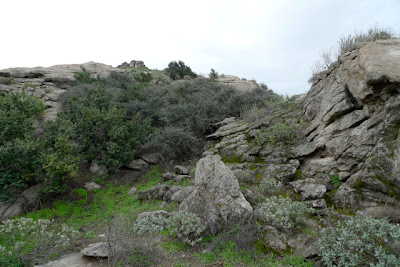[Rachel photographing the Jurupa Hills Oak in February 2011. Photo by Marie Regan.]
About six months ago I got an email from a biologist at UC Davis telling me about a discovery that he and his colleagues made down near UC Riverside. It was a clonal scrub oak, Quercus palmeri, that's at least 13,000 years old, and might actually be twice that. The biologist, Jeffery Ross-Ibarra, saw an article about my project on CNN and thought I might be interested in including their discovery in my project. He was right.
This past week I flew out to Los Angeles, along with my friend and wonderful filmmaker Marie Regan, who is capturing the first documentary footage for the Oldest Living Things in the World project. We drove to Riverside, where we met up with Jeffery (who just happened to be in town for a conference), and Mitch Provance, who was the first person to have a hunch that the Oak was something out of the ordinary. We also met Andy Sanders, master of the UCR Herbarium, who helped Mitch confirm his hunch. Over a decade later, their paper was published, confirming the minimum age of 13,000 years, and conferring the title of oldest continuously living organism in Southern California. (Though it's got nothing on the 80,000-year-old Quaking Aspen clone, Pando, in Utah.)
See that silvery, sagey looking shrub? That's it. The bright green in the foreground actually belongs to a type of Cherry. The Oak clone extends over the ridge of the hillside, though not down the other side. It found a purchase on this steep hillside at a time when mastodon and camels still roamed the area, and has quietly persisted ever since, even as housing developments, a cement factory, containers filled with modular home components, and the traffic of off-road vehicles became its new neighbors.
It's a difficult climb to the top (especially when dividing ones attention between maintaining ones footing and safely transporting ones camera equipment), but I'm sure that's what has afforded the Oak the off-the-beaten path anonymity that allowed it to survive into the present.


